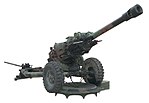The BurundiNational Defence Force is the state military organisation responsible for the defence of Burundi.
The Cameroon Armed Forces are the military of the Republic of Cameroon. The armed forces number 40,000 personnel in ground, air, and naval forces. There are approximately 40,000 troops in the army across three military regions. Approximately 1,300 troops are part of the Cameroonian Navy, which is headquartered at Douala. Under 600 troops are part of the Air Force. There is an additional 12,500 paramilitary troops that serve as a gendarmerie or reconnaissance role.
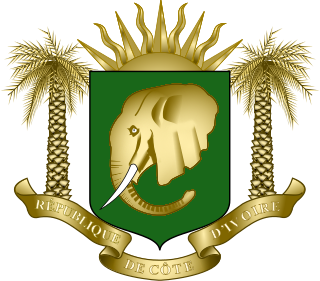
The Armed Forces of Côte d'Ivoire are the armed forces of Ivory Coast.

The Djibouti Armed Forces are the military forces of Djibouti. They consist of the Djiboutian National Army and its sub-branches the Djiboutian Air Force and Djiboutian Navy. As of 2018, the Djibouti Armed Forces consists of 20,470 ground troops, which are divided into several regiments and battalions garrisoned in various areas throughout the country. The Djibouti Armed Forces are an important player in the Bab-el-Mandeb and Red Sea.
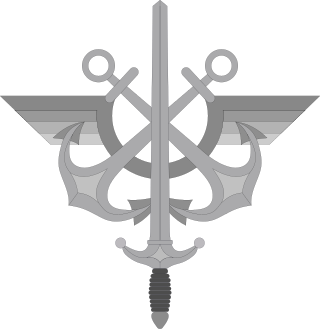
The French Armed Forces are the military forces of France. They consist of four military branches – the Army, the Navy, the Air and Space Force and the National Gendarmerie. The National Guard serves as the French Armed Forces' military reserve force. As stipulated by France's constitution, the president of France serves as commander-in-chief of the French military. France has the ninth largest defence budget in the world and the third largest in the European Union (EU). It also has the largest military by size in the EU. As of 2021, the total active personnel of the French Armed Forces is 270,000. While the reserve personnel is 63,700, for a total of 333,000 personnel. Including the active personnel of the National Gendarmerie, the total men power of all the French Armed Forces combined is 435,000 strong. A 2015 Credit Suisse report ranked the French Armed Forces as the world's sixth most powerful military.
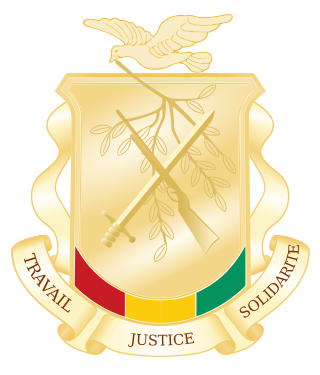
The Guinean Armed Forces are the armed forces of Guinea. They are responsible for the territorial security of Guinea's border and the defence of the country against external attack and aggression.
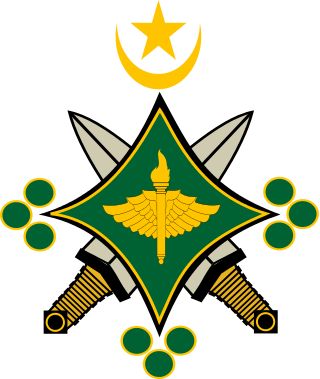
The Armed Forces of Mauritania is the defense force of the Islamic Republic of Mauritania, having an army, navy, air force, gendarmerie, and presidential guard. Other services include the national guard and national police, though they both are subordinated to the Ministry of the Interior. As of 2018, the Mauritanian armed forces budget was 3.9% of the country's GDP.
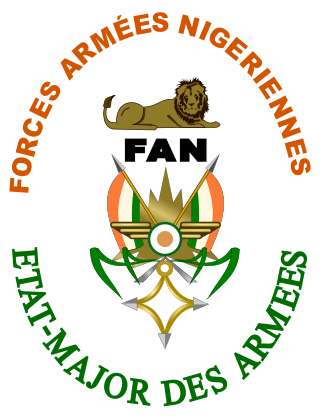
The Niger Armed Forces includes military armed force service branches, paramilitary services branches and the National Police of Niger. The Army, Air Force and the National Gendarmerie are under the Ministry of Defense whereas the National Guard and the National Police fall under the command of the Ministry of Interior. With the exception of the National Police, all military and paramilitary forces are trained in military fashion. The President of Niger is the supreme commander of the entire armed forces. The National Assembly of Niger passed a statute for the Army of Niger in November 2020, planning for the army's size to increase from 25,000 personnel in 2020, to 50,000 in 2025 and finally 100,000 in 2030.
The Armed Forces of Senegal consists of about 17,000 personnel in the army, air force, navy, and gendarmerie. The Senegal military force receives most of its training, equipment, and support from France and the United States. Germany also provides support but on a smaller scale.

The Sudanese Armed Forces are the military forces of the Republic of the Sudan. In 2011, IISS estimated the forces' numbers at 109,300 personnel. The CIA estimates that, before the current war in Sudan broke out in 2023, the SAF may have had up to 200,000 personnel. In 2024, Al Jazeera reported that the SAF has around 300,000 personnel.

A brigade is a major tactical military formation that typically comprises three to six battalions plus supporting elements. It is roughly equivalent to an enlarged or reinforced regiment. Two or more brigades may constitute a division.

The Turkish Land Forces is the main branch of the Turkish Armed Forces responsible for land-based military operations. The army was formed on November 8, 1920, after the collapse of the Ottoman Empire. Significant campaigns since the foundation of the army include suppression of rebellions in Southeast Anatolia and East Anatolia from the 1920s to the present day, combat in the Korean War, the 1974 Turkish invasion of Cyprus and the current Turkish involvement in the Syrian civil war, as well as its NATO alliance against the USSR during the Cold War. The army holds the preeminent place within the armed forces. It is customary for the Chief of the General Staff of the Turkish Armed Forces to have been the Commander of the Turkish Land Forces prior to his appointment as Turkey's senior ranking officer.

The Bastille Day military parade, also known as the 14 July military parade, translation of the French name of Défilé militaire du 14 juillet, is a French military parade that has been held on the morning of Bastille Day, 14 July, each year in Paris since 1880, almost without exception. The parade passes down the Avenue des Champs-Élysées from Place Charles de Gaulle, centred around the Arc de Triomphe, to the Place de la Concorde, where the President stands, along with members of the Government, figures from the legislative branch, the Mayor of Paris, as well as foreign ambassadors to France.
The Algerian Land Forces are the land forces of the Algerian People's National Army. The forces' equipment is mostly supplied by Russia and China.

The Moldovan Ground Forces, known officially as Land Forces Command is the land armed-forces branch of the National Army of the Moldovan Armed Forces. The Moldovan Ground Forces date back to the dissolution of the Soviet Union between 1991 and 1992. As of 2018 the Moldovan Ground Forces consists of around 4,000 personnel.

Troops began wearing berets as a part of the headgear of military uniforms in some European countries during the 19th century; since the mid-20th century, they have become a component of the uniforms of many armed forces throughout the world. Military berets are usually pushed to the right to free the shoulder that bears the rifle on most soldiers, but the armies of some countries, mostly within Europe, South America, and Asia, have influenced the push to the left.
Commandant is a military rank used in many - typically Francophone or Hispanophone - countries, where it is usually equivalent to the rank of major.
The Zambian Army is the land military branch of the Zambian Defence Force. Like all branches of the Zambian military, citizens of the nation are required to register at 16 years old, and citizens can join at 16 years old with parental consent or at 18 years old when they are classified as adults by Zambia. There is currently no conscription. Applicants must be Zambian citizens and must have a school Grade 12 certification. Applicants must also undergo a test for HIV on enlistment. Personnel can serve until age 55, when there is a mandatory retirement. Its first Commander Major General was Michael Grigg, appointed by Kenneth Kaunda. The first local Commander was Gen Kingsley Chinkuli. According to the 2014 CIA World Factbook: The current National Army Commander is Lieutenant General Geoffrey Choongo Zyeele and his deputy is Major General Luswepo Sinyinzawho who were both appointed by President Hakainder Hichilema on 12 September 2024.














